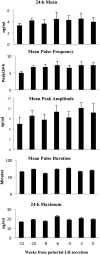A Reevaluation of the Question: Is the Pubertal Resurgence in Pulsatile GnRH Release in the Male Rhesus Monkey (Macaca mulatta) Associated With a Gonad-Independent Augmentation of GH Secretion?
- PMID: 26181107
- PMCID: PMC4588823
- DOI: 10.1210/EN.2015-1421
A Reevaluation of the Question: Is the Pubertal Resurgence in Pulsatile GnRH Release in the Male Rhesus Monkey (Macaca mulatta) Associated With a Gonad-Independent Augmentation of GH Secretion?
Abstract
A somatic signal has been posited to trigger the pubertal resurgence in pulsatile GnRH secretion that initiates puberty in highly evolved primates. That GH might provide such a signal emerged in 2000 as a result of a study reporting that circulating nocturnal GH concentrations in castrated juvenile male monkeys increased in a 3-week period immediately preceding the pubertal resurgence of LH secretion. The present study was conducted to reexamine this intriguing relationship, again in an agonadal model. Four castrated juvenile male monkeys were implanted with indwelling jugular catheters, housed in remote sampling cages, and subjected to 24 hours of sequential blood sampling (every 30 min) every 2 weeks from 19.5 to 22 months of age. Twenty-four-hour profiles of circulating GH concentrations were analyzed using the pulse detection algorithm, PULSAR, and developmental changes in pulsatile GH release with respect to the initiation of the pubertal rise of LH secretion (week 0; observed between 22.5 and 32 mo of age) were examined for significance by a repeated-measures ANOVA. Changes in the parameters of pulsatile GH secretion, including mean 24-hour GH concentration and GH pulse frequency and pulse amplitude for 3 (n = 4) and 6 (n = 3) months before week 0 were unremarkable and nonsignificant. These findings fail to confirm those of the earlier study and lead us to conclude that the timing of the pubertal resurgence of GnRH release in the male monkey is not dictated by GH. Reasons for the discrepancy between the two studies are unclear.
Figures




References
-
- Plant T, Terasawa E, Witchel SF. Puberty in non-human primates and man. In: Plant TM, Zeleznik A, eds. Knobil and Neill's Physiology of Reproduction. Vol 2 4th ed San Diego: Elsevier; 2015:1487–1536.
-
- Conte FA, Grumbach MM, Kaplan SL. A diphasic pattern of gonadotropin secretion in patients with the syndrome of gonadal dysgenesis. J Clin Endocrinol Metab. 1975;40:670–674. - PubMed
-
- Plant TM. A study of the role of the postnatal testes in determining the ontogeny of gonadotropin secretion in the male rhesus monkey (Macaca mulatta). Endocrinology. 1985;116:1341–1350. - PubMed
-
- Pohl CR, deRidder CM, Plant TM. Gonadal and nongonadal mechanisms contribute to the prepubertal hiatus in gonadotropin secretion in the female rhesus monkey (Macaca mulatta). J Clin Endocrinol Metab. 1995;80:2094–2101. - PubMed
-
- Plant TM, Fraser MO, Medhamurthy R, Gay VL. Somatogenic control of GnRH neuronal synchronization during development in primates: a speculation. In: Delamarre-van de Waal HA, Plant TM, van Rees GP, Schoemaker J, eds. Control of the onset of puberty III. Amesterdam: Excerpta Medica; 1989:111–121.

